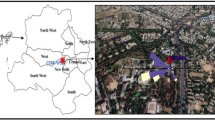Abstract
Source apportionment study is carried out to identify the sources of particulate matter of size less than 10 μm in Mumbai using chemical mass balance model. Various locations representing different activity zones as low activities (control), normal activity including commercial and residential areas and traffic sites (kerbside) are selected for this purpose to represent the city. It is observed that at control sites industrial contributions prevail, the other significant contributions are from marine and vehicular activities. At normal activity sites, vehicular, industrial and soil dust contributions are observed to be dominant. At two of the kerbside sites, marine contributions are observed to be significant which was due to the proximity of the sites to sea. The vehicular and soil dust contributions are observed to be significant at remaining kerbside sites. The study is useful for preparing the particulate matter reduction action plan for Mumbai, which can be extended further to other cities of India.

Similar content being viewed by others
References
Bhanarkar AD, Rao PS, Gajghate DG, Nema P (2005) Inventory of SO2, PM and toxic metal emissions from industrial sources in greater Mumbai, India. Atmos Environ 39:3851–3864. doi:10.1016/j.atmosenv.2005.02.052
Breed CA, Arocena JM, Sutherland D (2002) Possible sources of PM10 in Prince George (Canada) as revealed by morphology and in situ chemical composition of particulate. Atmos Environ 36:1721–1731. doi:10.1016/S1352-2310(01)00500-3
Center for Science and Environment (2001) Inside story of how the government institution and groups have conspired to compromise the Delhi’s public health. Down to Earth, CSE, New Delhi, 30 September 2001
Chelani AB, Gajghate DG, Phadke KM, Gavane AG, Nema P, Hassan MZ (2005) Air quality status and sources of PM10 in Kanpur city. Bull Environ Contam Toxicol 74(2):421–428. doi:10.1007/s00128-004-0601-z
Gupta AK, Karar K, Srivastava A (2007) Chemical mass balance source apportionment of PM10 and TSP in residential and industrial sites of an urban region of Kolkata, India. J Hazard Mater 142:279–287. doi:10.1016/j.jhazmat.2006.08.013
Katz M (1977) Methods for air sampling and analysis, 2nd edn. APHA Press Inc, Springfield, VA
NEERI (2004) Particulate matter reduction action plan for greater Mumbai region. NEERI, Nagpur, India
Samara C, Kouimtzis T, Tsitouridou R, Kanias G, Simeonov V (2003) Chemical mass balance source apportionment of PM10 in an industrialized urban area of northern Greece. Atmos Environ 37:41–54. doi:10.1016/S1352-2310(02)00772-0
Schwartz J, Dockery DW, Neas LM (1996) Is daily mortality associated specifically with fine particles? J Air Waste Manage Assoc 46:927–939
Shah JJ, Nagpal T (1997) Urban air quality management strategy in Asia; Greater Mumbai Report, World Bank Technical Paper No. 381
Sharma VK, Patil RS (1994) Chemical mass balance model for source apportionment of aerosols in Bombay. Environ Monit Assess 29:75–88. doi:10.1007/BF00546780
Srivastava A, Jain VK (2007) Seasonal trends in coarse and fine particle sources in Delhi by the chemical mass balance receptor model. J Hazard Mater 144:283–291. doi:10.1016/j.jhazmat.2006.10.030
Tripathi RM, Vinod Kumar A, Manikandan ST, Bhalke S, Mahadevan TN, Puranik VD (2004) Vertical distribution of atmospheric trace metals and their sources at Mumbai, India. Atmos Environ 38:135–146. doi:10.1016/j.atmosenv.2003.09.006
USEPA (1997) Chemical mass balance receptor model version 8 (CMB8), user manual. Research Triangle Park, NC, Desert Research Institute, Reno, NV
Vinod Kumar A, Patil RS, Nambi KSV (2001) Source apportionment of suspended particulate matter at two traffic junctions in Mumbai, India. Atmos Environ 35:4245–4251. doi:10.1016/S1352-2310(01)00258-8
Watson JG, Chow JC, Pace TG (1991) Chemical mass balance. In: Hopke PK (ed) Receptor modeling for air quality management. Elsevier Press, New York, NY, pp 83–116
Watson A, Samara C (2005) Levels of total suspended particulate matter and major trace elements in Kosovo: a source identification and apportionment study. Chemosphere 59:669–678. doi:10.1016/j.chemosphere.2004.10.056
Acknowledgments
The authors are thankful to the colleagues from Air Pollution Control Division of NEERI, Nagpur for their support to generate the data.
Author information
Authors and Affiliations
Corresponding author
Rights and permissions
About this article
Cite this article
Chelani, A.B., Gajghate, D.G. & Devotta, S. Source Apportionment of PM10 in Mumbai, India Using CMB Model. Bull Environ Contam Toxicol 81, 190–195 (2008). https://doi.org/10.1007/s00128-008-9453-2
Received:
Accepted:
Published:
Issue Date:
DOI: https://doi.org/10.1007/s00128-008-9453-2




